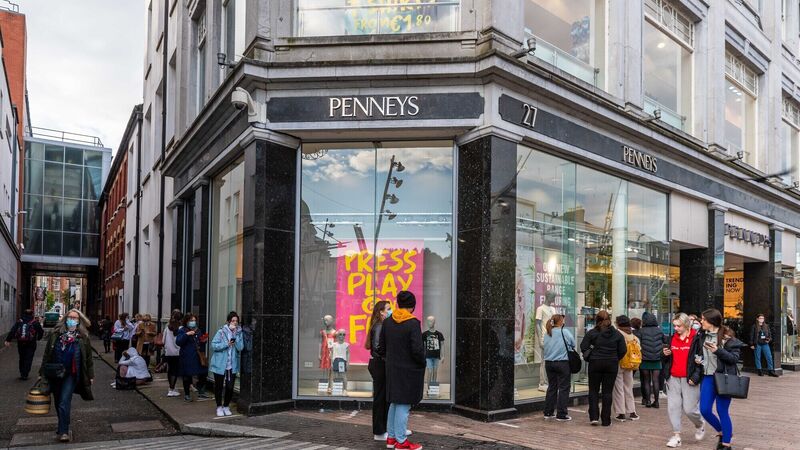Clodagh Finn: ‘Thanks, Penneys’ best.’ Phrase that dressed a nation has to change

Recall the queues when Penneys reopened, post-lockdown. One wag said they were visible from the moon. Picture: Andy Gibson
As recently as last Saturday, I admired a woman’s dress and she said: “Thanks, Penneys’ best.”
Then she did that thing we Irish women do when complimented; she looked down, plucked gently at what she was wearing, as if to say “this old thing” before shrugging off the attention.
Though she did go on to add: “Sure, where would we be without Penneys?”
And where would we be without that great democratiser of fashion, which has made clothes accessible and affordable to the masses ever since it opened its doors on Mary St, Dublin, in 1969? I think it is fair to say that every Irish woman, and more than a few men, have had similar Penneys exchanges.
Some will even tell you that people learning English in Ireland think that “Penneys, thanks” is the correct response to a compliment. They’ll tell you of the Japanese/Polish/German woman who responded “Penneys, thanks” when a new haircut/outfit/accessory was admired.
Language-learners with a particular ear for local idiom might even go the full “Penneys, thanks hun”, or so the tale goes, though I have yet to meet a person who has actually witnessed this first-hand. All the same, the story shows just how much Penneys has worked its way into the warp and weft of the Irish retail experience.
Recall the queues when Penneys reopened, post-lockdown. One wag said they were visible from the moon. It was only a slight exaggeration. Others spoke of selling Penneys appointments on the black market, or facing a dilemma when their vaccine appointment clashed with their long-awaited chance to “just pop in for a few bits”.
Even without an online presence, it not only survived but is going on to thrive.
The discount-clothing store didn’t have a single customer on the day it opened more than 50 years ago, but now it has 37 outlets in Ireland and more than 10 times that number in 14 countries across Europe and America, where it operates under the label Primark.
It really means something, then, when a company with such global reach publishes a 10-year sustainability plan, as Penneys/Primark did last week.
Chief executive Paul Marchant spoke of the brand’s commitment to sustainability, and outlined the Primark Care plan, which aims to halve the company’s carbon footprint over the next decade.
The plan has three broad aims. It hopes to give clothes a longer life, reduce the brand’s impact on the planet, and improve the livelihoods of the people who make their products.
It is encouraging to hear talk of meaningful change by a fashion giant, particularly as the clothing industry globally accounts for up to 10% of all carbon emissions and almost 20% of wastewater.
It is more encouraging still to hear the producers of mass-marketed fashion speak about ensuring that all workers in their supply chain earn a living wage.
The plan, though, was greeted with a healthy dollop of scepticism, not least because it is hard to see how those changes can come without an increase in prices.
Geraldine Carton of Sustainable Fashion Dublin said she was hesitating before cheering from the rooftops. Instead, she responded with a combination of tentative hope and cynicism, because she said the brand had shown little evidence of sustainability in the past.
For her, the way ahead is two-pronged. There needs to be a move to sustainable practices in the fashion industry, but also a shift in thinking among consumers who have come to consider clothing in the same way as, say, a throwaway straw.
She hit the nail on the head. We have to change how we think about fashion. Part of the appeal of Penneys is its low prices. That, of course, has been a lifesaver for so many households who have been able to dress themselves and their children without breaking the bank.
The downside of a good bargain, however, is that we have come to see fashion as disposable. The idea of darning a sock seems almost prehistoric now. I wonder if anyone under the age of 30 (even 40) knows how to do it. And why would you when you can buy five new pairs of socks for less than a fiver?
That is not to suggest that everyone take up the darning needle, though there are worse things. It is time, though, to look at how we consume — and that’s the right verb — fashion, and in particular fast fashion.
Cast your mind back to the heatwave of July, when temperatures topped 30C in an extreme weather event that scientists said was a sign of the climate change that is now “widespread, rapid and intensifying”.
Somewhere in the far reaches of our minds, we were aware of the urgent need for immediate, rapid and largescale reductions in greenhouse gases, even if the implications of failing do so, outlined in the recent Intergovernmental Panel on Climate Change Report, are too vast to fully comprehend.
It was much easier to prepare for the hot weather with a trip to Penneys to buy three or four new t-shirts. When the storms and downpours hit us — and they will come — we will probably go back to stock up on raingear.
Or we can do something else and start to link what we buy to what is happening in the world around us.
If you buy, say, four more t-shirts at any outlet, not just at Penneys, you might be getting a short-term bargain, but what is the longer-term cost in terms of emissions from production, transport, and, later, waste?
One person’s shopping basket might not make that much difference, but if you multiply it by the thousands who shop in Penneys' 37 branches here and its 300-plus Primark outlets around the world, the picture starts to look very different.
The whole fashion industry in its current format is unsustainable, to quote Damien O’Reilly, lecturer in retail at Technological University Dublin. He talks of the need for a circular fashion system where clothes are designed to be recycled or recommerced, that is when material from garments is later used in other products, such as sofas and cushions.
While much of that change is driven by younger, more aware consumers, the disposable culture is still deeply ingrained. For instance, 35% of the products ordered from British online retailer Asos are sent back, and about 50% of those are sent to landfill because they are creased or damaged in some way.
If producers can make mass-marketed clothes sustainable and consumers can stop thinking of fashion as throwaway, we might start to see real change.
As for Penneys, the brand is doing what it can. We might join in by watching how we spend on fashion, not just there but in all outlets. Take care of the pennies and the planet might begin to look after itself.
CLIMATE & SUSTAINABILITY HUB














